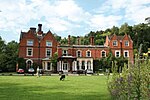Westhumble

Westhumble is a village in south east England, approximately 2 km (1.2 mi) north of Dorking, Surrey. The village is not part of a civil parish, however the majority of the settlement is in the ecclesiastical Parish of Mickleham. The area is served by Box Hill & Westhumble railway station.Norbury Park (managed by Surrey Wildlife Trust) is immediately to the north and there are several National Trust properties nearby, including Box Hill and Polesden Lacey. The Mole Gap Trail runs through the village, crossing the North Downs Way less than 0.40 km (0.25 mi) to the south. The railway station is the southern terminus of the Thames Down Link walking route from Kingston upon Thames.
Excerpt from the Wikipedia article Westhumble (License: CC BY-SA 3.0, Authors, Images).Westhumble
Chapel Lane, Mole Valley
Geographical coordinates (GPS) Address Nearby Places Show on map
Geographical coordinates (GPS)
| Latitude | Longitude |
|---|---|
| N 51.254 ° | E -0.333 ° |
Address
Chapel Lane
Chapel Lane
RH5 6AL Mole Valley
England, United Kingdom
Open on Google Maps










